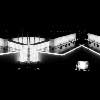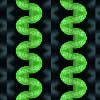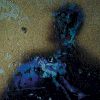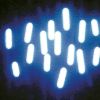Peripatetic Media: Ian Andrews and the Philosophers Video: Video Art from 1981-2001, a Paul Andrew Reflective
A screen is a surface that displays pictures yet can hint that something is concealed behind it. It is an emblem of ambivalence about what can be seen and not seen, what is spectacularly fascinating and what is fascinatingly secret, what is pleasurable and what is fearful, what is conventionally acceptable and what is repressed.
Laura Mulvey, 1992
…the truth about truth is difficult to situate, impossible to express, but nonetheless endlessly inviting of whatever impassioned, misguided stories we can dream up to tell about it.
Adrian Martin 1999
Agit-prop humour, an unnerving wit and quixotic formalism underscore the prolific and exquisite video, sound and performance art of Ian Andrews. Electro-matic foregrounds the key works of a consummate bricoleur whose electo-filmic assemblages playfully examine and interrogate the information ether.
At once philosopher, cultural activist and media luminary, Ian Andrews’ work has evolved out of the post-punk anything goes milieu of the early eighties.
His random anarchic use of found images and incidental sounds are deployed and cut-up in his video art films, animations, sound/radio art. Combined with the deft implementation of analogue video synthesis, outmoded equipment, digital graphics and low-tech effects, Andrews elicits a mongrel and strange new media.
The advent of domestic video technology (Andrews was armed with two VCRs) in the 1980s ushered in a new chapter of art in the age of mechanical reproduction. This era witnessed a significant convergence of public and private in the information landscape.
This simple recording technology afforded artists and householders alike the newfound possibility for the contemplation of television. To archive it, review and repeat it, to pause and fast forward, to slo-mo and single frame view and to self-edit. Most notably it radically facilitated the altering and ‘personalizing’ of broadcaster programming.
For Ian Andrews this feel for new technology presaged a revolutionary interactivity with television that had traditionally impacted upon cultural belief systems as a ‘given’ since the 1950s. It was an opportunity to interrupt television for the first time, to ‘capture’ it and reveal its breaks in transmissions, its gaps, slippages, accidents, abstractions, its phantoms and concealed images.
Andrews and his peers collated vast personal archives from television. These “found” images and sounds became the touchstone for a life vigil of reframing, representing and recording familiar cultural formations.
Combined quite randomly with other found materials: discarded Super8 and 16mm film, reel to reel sound tapes and a plethora of electric sound grabs. Andrews has created prismatic assemblages which take to task the unthinking consumption of media. In doing so he has forged a hybrid, dystopic frequency for information’s renewal, contemplation, reflection and critique. His role since has been to evince a fantastic and mnemonic parallel media.
It is this reification of television, this hybrid alchemy that underpins all of Andrew’s electronic interventions. Joey: An Electomechanical Boy (1989) and The Harm Machine (1991) both poignantly emblematize this philosophical rupture.
Joey: An Electomechanical Boy (1989) a Super 8 film that is based on the real life story of a schizophrenic boy who lives as a machine. Juxtaposing appropriated television montages alongside a dramatized choreographic spiral of descent, Andrews anticipates the sensations of Joey’s ecstatic flight. The frenzied spectrum of machinic images and bodily images connote Joey’s odyssey towards the realm of binary code and electronic circuitry. Andrews speculates on the attendant sacrifice of imagination, emotion and the loss of subjectivity itself.
The Harm Machine (1991) parodies 1950s schlock horror and sci-fi films. This prismatic film reframes and satirizes the anxious television and film images of the Cold War period and the Arms Race introduced technological developments since the 1950s. Machine gun paced montages and peripatetic cut-ups and juxtapositions from ‘terrorvision.’ Collisions of panic stricken faces, images of labyrinthine computer metropolises, dark architecture and an ethereal, foreboding soundscape represent the schism between mythic perceptions of an imminent technological apocalypse and the futuristic potential for sentient technologies.
Phonogram (1992) echoes the recurring schizophrenic subtext in Andrews’ works. The fast paced convergences of bodies and machines and appropriated images are intercut with narrative drama. This multinarrative film portrays a sensitive office clerk’s relationship to old and new technologies, the differing ways to archive and sore personal information and the complexities of information/memory retrieval. Andrews questions traditional relationships to information and privacy in the spectre of burgeoning surveillance technologies.
Zeroville (1993) in this faux Jean Luc Godard film, secret agent Johnny Antipodies is a maverick hacker who upends a pedagogic information monopoly. Zeroville is Andrew’s most narratively driven film with a sparing usage of montage and appropriated images.
Programme (1996) re-presents found home movie footage from the 1950s, which portrays the activities of a boy’s military training institution in Sydney. Here Andrews shifts gear from the fast editing style and uses found images with abundant repetitions and loops to discern a more abstracted and contemplative form. He pay homage to Foucauldian ideas of institutional control and punitive systems. The loops and repetitions imbue Andrews’ work with a mesmeric style that paves the way for a newfound minimalism and self-reflexiveness in Andrews’ future works.
Data Panic (1998) resonates with a satirical and fast edit approach of earlier work. Andrews reveals the ironies and fears surrounding the information economy, its distribution networks and concealed dark subterfuge. Data Panic revisits Andrews’ fascination with the paranoiac mythologies fostered by the media to explain the fluctuations, mercurial nature and self-empowerment of technological change.
Forgotten Memory Series (2000) extends the loops, repetitions and meditative nature of films like Programme. Here Andrews pairs back hos appropriated media images to abstraction; a convergence of moving image and still. What Andrews terms “neo-minimalism.” These works parallel the spirit of Derek Jarman’s latter day films, whose formal colour explorations invoked mood, emotions, alchemical references and has proffered transmutative qualities.
Similarly, Andrews’ later work concerns itself more with formalism: composition, saturated colours, deep saturated hues and gestural textures. He pairs back the peripatetic to allow for the contemplation of the formal. The prolific use of low-tech effects and hand rendering that are painterly and alchemical in appearance. For instance, Andrews used salt to treat and scratch the film. He has used discarded technology )an old titling Colouriser) to instil the video with a richer palette and paradoxically, a filmic appearance, to illuminate the ghost like subjects.
Ian Andrews’ analogue vigil invites us to interrogate the dizzying highs and lows of the information stratosphere to question easy consumption of difficult things. His incendiary, revealing assemblages inspire us to look at differing juxtapositions and imaginary frames of reference. As if to forge his own frequency of chaotic and deterritorialised broadcasting. Ian Andrews’ vast archive of hybrid “cut-ups” have presciently anticipated the current digital trend for self-publishing, web-camming and video streaming technologies.
The works in this festival simulate a prime-time programme selection from a dystopic television station. These are analogue prototypes which remind us to encompass and celebrate older technologies. These are important works that profoundly precede today’s web based activism also geared to culture jamming, advert busting and media deconstruction.
…A man that looks on glass,
On it may stay his eye,
or if he pleaseth, through it pass.
And then the heaven espy…
The Elixir, George Herbert


























